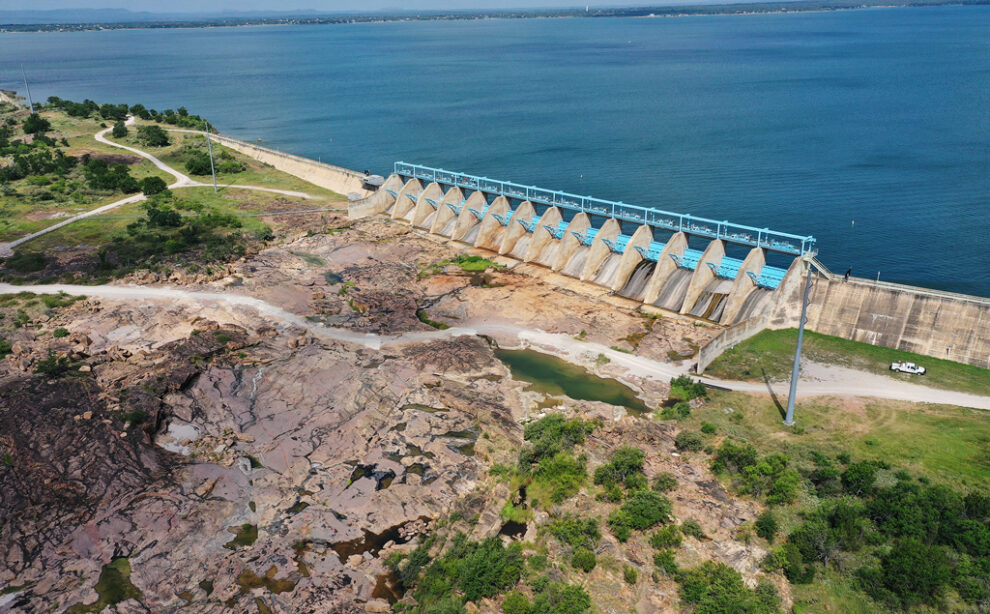MASON COUNTY, Texas (KXAN) — A dam that the Texas Parks and Wildlife Department and the U.S. Army Corps of Engineers say was constructed illegally in Mason County is blocking water from flowing toward the Highland Lakes, which serve as Austin’s drinking water supply.
A hydrologist told KXAN the sudden rise of new dam construction is part of a growing trend statewide, stressing dwindling water resources during a multi-year drought.
Mason County residents are concerned
“We share the rivers with everybody. We always have,” Mason County resident Kathy Zesch-Bradley said. “This land has been in my family since the 1850s, and no one has ever attempted to do this, but especially not having any permits.”
“Unfortunately, it’s a situation where people that have enormous amounts of money are able to do the things that they want that infringe upon the rights of all citizens of Texas,” Kathy’s husband Lee Zesch said.
“It’ll destroy our livelihood if that stands because our cattle won’t have water,” Kathy’s sister Susan Keeling, who lives downstream from the dam, said.
KXAN crews drove to Mason County to check, entering through the neighbor’s land with permission, then following the public riverbed upstream. Navigable rivers like the James River are public property, whether wet or dry, according to the Texas Parks and Wildlife Department.
After two to five inches of beneficial rain in the past month in Mason County, the dam is now holding back water five feet deep on the landowner’s side. Upon KXAN’s inspection, none of that water flowed downstream toward the Austin area
KXAN checked with the Mason County Clerk’s office, finding that the 404-acre plot of land was purchased by an entity called ‘Neusch Mason, LLC’ on May 19, 2023.
The Texas Commission on Environmental Quality confirmed to KXAN no one has applied for a permit to build a dam in Mason County this year.
The Texas Parks and Wildlife Department investigated the dam and issued a notice of violation letter to the landowner for failing to apply for a permit prior to construction.
The landowner also failed to get a permit from the U.S. Army Corps of Engineers, which issued a cease and desist letter to the landowner after visiting the property.

KXAN searched Mason County Appraisal District records and business filings, which link Bill Neusch to the LLC listed as the property owner.
Neusch is the CEO of Gibraltar, a Burnet-based company that builds anti-vehicle ram barriers and security fencing. The company has built and installed more than 150 miles of the Texas/Mexico border wall, according to its website.
KXAN went to Gibraltar to try to speak with Neusch. A receptionist told us he was on-site, but was unavailable to speak with us. KXAN also tried calling a phone number registered under his name, but the number had been disconnected.
KXAN connected with Neusch’s attorney, Jim Bryer, over e-mail. He told us his client is “unavailable for an interview,” and “we have no additional comment at this time.”
More Texas landowners are building dams, limiting river and lake recharge
KXAN showed photos of the dam to hydrologist Dr. Jordan Furnans. Furnans works for LRE Water, which is a water consulting firm based in Colorado.“Each individual pond is not very much, but when you add it all up, that’s a lot of water,” Furnans said. “This is really death by 10,000 cuts. And when I say 10,000, I mean 10,000.”
Furnans was hired to study a different watershed north of the James River in 2019. Analyzing satellite images of the San Saba, North Concho, South Concho and Elm Creek watersheds, he found 12,500 unregistered ponds holding an estimated 35,000 acre-feet of water. That is the equivalent of nearly five Lady Bird Lakes.
Through computer modeling, Furnans found that these ponds are capturing 15% of the water that would otherwise flow into rivers and lakes. His models found an additional 5% reduction in streamflow due to warmer temperatures, drier soil, and land use changes.
In the Brazos River basin, Furnans found more than 30,000 of these ponds capturing an estimated 8% of runoff.
In addition to impounding water, Furnans said the larger surface area of water created when water is dammed off enhances losses to evaporation.
“[Lake recharge] is just not going to be like it used to,” Furnans said. “You’re going to need that massive whopper of a storm that’s just going to overwhelm all of these small ponds and cause all this runoff to go in. We’re not getting those as frequently as we used to. Really, I would love to see all of these small ponds removed.”
It is important to note that while Furnans said all of those ponds are unregistered, they are not necessarily illegal. The Texas Commission on Environmental Quality and Texas Water Code allow landowners to build a water impoundment without a permit when:
- The impoundment is not located on a watercourse
- The impoundment has a normal storage capacity of 200 acre-feet or less, on average over a 12-month period, is only used for domestic and livestock purposes, and is constructed on a person’s “own property.” This exemption does not apply to a commercial operation
- The impoundment has a normal storage capacity of 200 acre-feet or less, is used for fish and wildlife management purposes, is constructed on a person’s “own property”, and the property is qualified open-space land. This exemption does not apply to a commercial operation
- The impoundment is part of a surface coal mining operation and is used for sediment control, fire suppression, or dust suppression
“I think this guy wanted to do it in the dark of night so to speak, so nobody would see it, and maybe this little town wouldn’t even notice,” downstream neighbor Susan Keeling said.
“Sometimes you just have to do the right thing because it’s the right thing,” Susan’s husband Jimmy Keeling said, “and building a dam so people downstream can’t get water is not the right thing. One individual can destroy it for the rest of us.”
Texas Parks and Wildlife and the U.S. Army Corps of Engineers said they hope to coordinate with the landowner to reach a desirable solution.
After an in-person inspection Aug. 25, the Texas Commission on Environmental Quality told KXAN their investigation into the dam is ongoing.
KXAN has also received viewer tips of other dams constructed on Elm Creek and Leon Creek. Investigations into those are ongoing.
Source : Kxan











